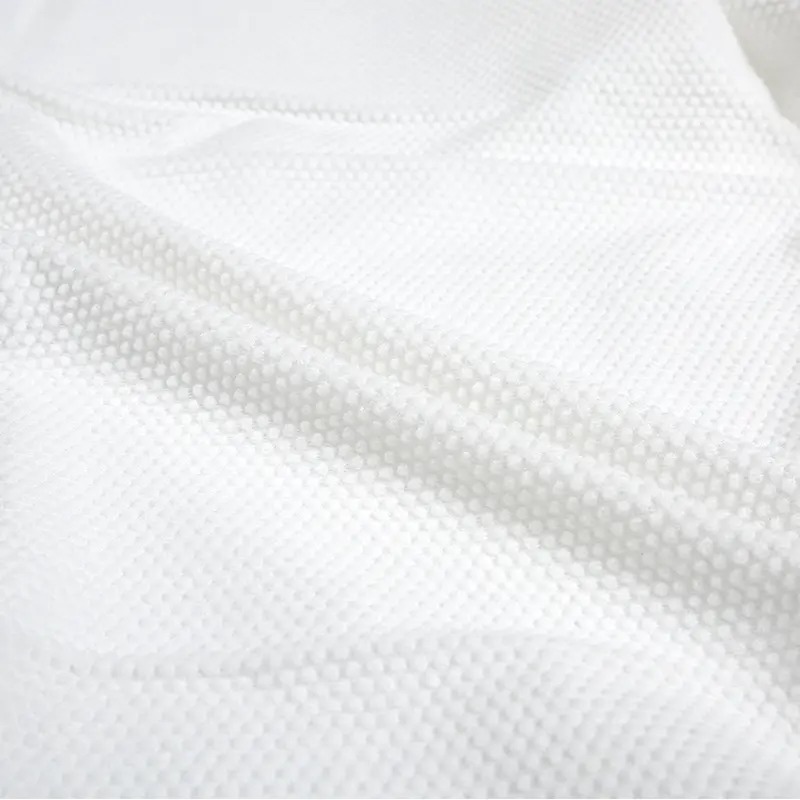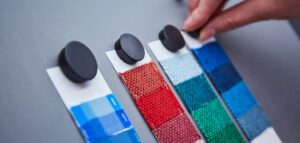Embossed Spunlace Nonwoven – Technology, Properties, and Advantages
The nonwoven industry has become one of the fastest-growing sectors in global textiles, driven by the need for high-performance, eco-friendly, and versatile fabrics. Among its many innovations, Embossed Spunlace Nonwoven stands out as a material that blends advanced hydroentanglement technology with embossing techniques to create fabrics that are not only functional but also aesthetically appealing.
From baby wipes and medical dressings to industrial cleaning cloths and high-end packaging, embossed spunlace fabrics are redefining the standard for nonwoven applications. Their ability to combine strength, softness, absorbency, and design flexibility makes them indispensable across healthcare, beauty, hygiene, hospitality, and technical industries.
This article explores in depth the technology, manufacturing process, properties, advantages, and applications of embossed spunlace nonwoven, highlighting why it has become a cornerstone of modern nonwoven innovation.
What is Embossed Spunlace Nonwoven?
Spunlace nonwoven fabric is made through hydroentanglement, a process where high-pressure water jets are directed onto a web of fibers. These jets entangle the fibers mechanically, forming a strong and uniform fabric without adhesives or binders. This technology produces materials that are safe, eco-friendly, soft, and highly absorbent.
The embossing process adds another dimension. By passing the spunlace fabric through engraved rollers, embossed patterns are created. These designs—whether honeycomb, pearl dots, wavy textures, or customized motifs—not only enhance surface aesthetics but also increase fabric functionality. Patterns add depth, improve absorbency, provide anti-slip properties, and even mask minor production inconsistencies.
In short, embossed spunlace nonwoven combines the scientific precision of hydroentanglement with the artistry of embossing, delivering fabrics that excel in both performance and appearance.
Manufacturing Process of Embossed Spunlace Nonwoven
The production of embossed spunlace nonwoven is a carefully controlled process involving multiple stages:
1. Fiber Selection and Preparation
The journey begins with the choice of raw materials. Commonly used fibers include:
Viscose – Offers softness, absorbency, and biodegradability.
Polyester – Provides strength, durability, and cost efficiency.
Cotton – Natural, skin-friendly, and breathable.
Bamboo or PLA fibers – For eco-conscious, biodegradable applications.
Often, blends are used to balance performance and sustainability.
2. Web Formation
The selected fibers are carded and laid into a uniform fiber web. In embossed spunlace, web uniformity is critical, as it directly affects embossing clarity and product performance.
3. Hydroentanglement (Spunlace Process)
This is the heart of spunlace technology. High-pressure water jets penetrate the fiber web, entangling fibers to create a strong yet soft nonwoven. Hydroentanglement ensures the fabric maintains integrity without chemical binders, enhancing safety and eco-friendliness.
4. Embossing Process
The entangled web is then passed through embossing rollers engraved with specific patterns. Embossing not only improves fabric design but also alters its tactile and functional properties. For example:
Pearl dot patterns enhance softness and absorption.
Honeycomb embossing improves strength and scrubbing ability.
Wavy designs enhance flexibility and grip.
5. Drying and Finishing
The embossed web is dried, typically using hot-air systems. At this stage, special finishes may be added depending on the end-use, such as antibacterial coatings, hydrophobic treatments, or flame retardancy.
6. Cutting, Rolling, and Packaging
Finally, the finished fabric is slit into desired widths, rolled, and packaged. Before shipment, it undergoes strict quality inspections for thickness, weight, tensile strength, absorbency, and visual uniformity.
Key Properties of Embossed Spunlace Nonwoven
Embossed spunlace fabrics combine the benefits of spunlace technology with added value from embossing. Their properties include:
Softness and Comfort – Gentle on skin, ideal for hygiene, medical, and cosmetic applications.
High Absorbency – Embossed textures improve liquid uptake and retention.
Strength and Durability – Hydroentangled fibers provide high tensile and tear resistance.
Low Linting – Reduced fiber shedding ensures safety in sensitive environments like healthcare or electronics.
Breathability – Air-permeable structure makes it comfortable for medical gowns, masks, and hygiene products.
Aesthetic Appeal – Embossed patterns add visual and tactile appeal for consumer-facing products.
Eco-Friendly Potential – Can be made from biodegradable or recycled fibers, aligning with sustainability goals.
Functional Versatility – Can be tailored with antibacterial, hydrophobic, or flame-retardant properties.
Advantages of Embossed Spunlace Over Conventional Nonwovens
Performance and Design in One Fabric – Unlike plain spunlace, embossed spunlace adds visual and functional benefits.
Enhanced Absorbency – Embossing increases surface area, boosting fluid capture.
Customizability – Patterns can be tailored to brand identity or specific functions.
Eco-Friendly Production – Binder-free hydroentanglement and use of biodegradable fibers reduce environmental impact.
Better Consumer Experience – Softness, aesthetics, and hygiene combine to improve product acceptance.
Multi-Sector Adaptability – Suitable for hygiene, medical, industrial, and lifestyle applications.
Applications Across Industries
1. Personal Care and Hygiene
Embossed spunlace fabrics are widely used in personal care due to their softness and absorbency:
Baby wipes and diapers: Gentle and highly absorbent.
Feminine hygiene products: Breathable and comfortable.
Adult incontinence care: Durable and skin-friendly.
2. Beauty and Cosmetics
In beauty applications, embossed patterns enhance user experience:
Facial masks: Retain serum for efficient absorption.
Makeup remover pads: Durable, lint-free, and soft.
Spa towels and wipes: Hygienic, absorbent, and aesthetically pleasing.
3. Medical and Healthcare
The medical industry values embossed spunlace for its safety, breathability, and strength:
Surgical gowns and drapes: Protective yet breathable.
Wound dressings: Soft and absorbent for sensitive skin.
Hospital wipes: Strong and hygienic, essential for infection control.
4. Household and Hospitality
Embossed spunlace has become a staple in cleaning and hospitality:
Kitchen and floor wipes: Effective scrubbing and liquid absorption.
Restaurant service wipes: Hygienic, lint-free, and visually appealing.
Disposable dry towels: Convenient and eco-friendly alternatives to cotton.
5. Industrial and Technical Applications
Industrial sectors value embossed spunlace for its strength and versatility:
Automotive interiors: Used as liners, insulation, and wipe cloths.
Electronics cleaning: Low-lint fabric prevents contamination.
PU/PVC leather base cloth: Provides strength and stability in synthetic leathers.
Why Embossing Matters in Spunlace Nonwoven
The embossing process is more than cosmetic—it’s functional:
Enhanced Absorbency: Patterns increase fluid retention.
Grip and Handling: Raised textures improve anti-slip performance.
Tactile Comfort: Softer and more luxurious feel for consumer products.
Defect Masking: Hides small surface flaws from hydroentanglement.
Brand Differentiation: Custom patterns support product identity in competitive markets.
Conclusion
Embossed Spunlace Nonwoven represents a unique synergy of hydroentanglement technology and embossing design. With properties such as softness, absorbency, strength, low linting, and eco-friendliness, it has become a material of choice for applications ranging from hygiene and medical to industrial and lifestyle products.
Its ability to combine functionality with aesthetics ensures consumer acceptance, while its adaptability to sustainable raw materials aligns with global trends. As industries continue to seek high-quality, environmentally responsible fabrics, embossed spunlace nonwoven will remain at the forefront of innovation in the nonwoven sector.
While the technology and advantages of embossed spunlace nonwoven are clear, its long-term success depends on sustainability and market dynamics. In the next part of this series, we explore the sustainable production practices, cost considerations, and future market trends shaping this innovative material





